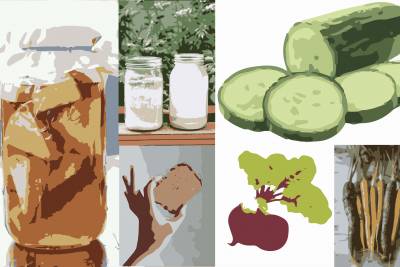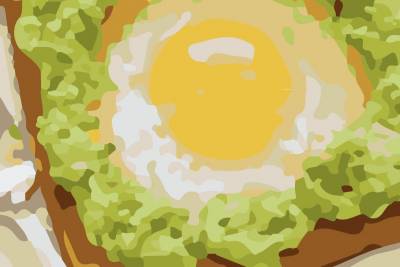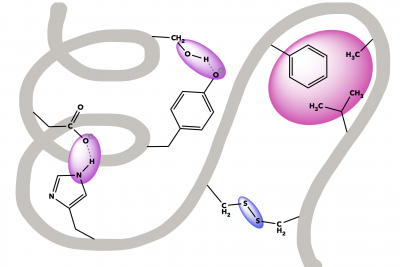Explore How Light Affects Photosynthesis
Background
Algae are aquatic, plant-like organisms that can be found in oceans, lakes, ponds, rivers, and even in snow. But don’t worry, if you’re not near a waterway, it can easily be ordered from Amazon or Carolina Biological. Algae range from single-celled phytoplankton (microalgae) to large seaweeds (macroalgae). Phytoplanktons can be found drifting in water and are usually single-celled. They can also grow in colonies (group of single-cells) that are large enough to see with the naked eye. The specific types of algae that can be used in this experiment are Scenedesmus, Chlamydomonas, or Chlorella, all of which are phytoplanktons or microalgae.

Even though algae are quite similar to plants, they are classified as Protists. Unlike plants, they lack specialized structures like roots, stems, and leaves. They do however, contain chlorophyll which give them the ability to perform photosynthesis; they use sunlight to convert carbon dioxide and water into energy and oxygen.  The limiting factors that affect the rate of photosynthesis are carbon dioxide concentration, temperature, and light intensity. For this experiment students will explore how to change the rate of photosynthesis in algae by using a variety of light sources and intensities.
The limiting factors that affect the rate of photosynthesis are carbon dioxide concentration, temperature, and light intensity. For this experiment students will explore how to change the rate of photosynthesis in algae by using a variety of light sources and intensities.
Materials
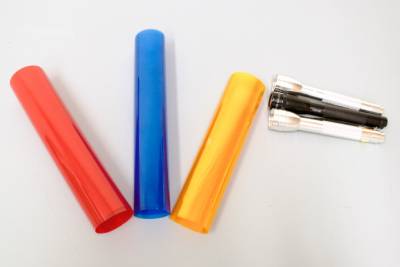
Experimental variables
- Color filter paper
- Table/desk lamp
- Light bulbs (varying intensities and colors)
- Ruler

Laboratory Supplies
- Strainers
- Transfer pipettes
- Water
- Vials with caps
- Freshwater Algae (Scenedesmus, Chlorella, or Chlamydomonas)
- Small beakers or cups
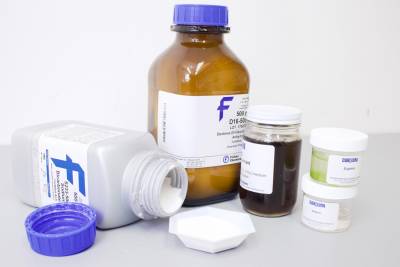
Laboratory Solutions
- 2% Calcium Chloride
- 2% Sodium alginate
- Cresol red/thymol blue pH indicator solution
Solution Preparations
2% Calcium Chloride (CaCl2)
- 20 g of CaCl2
- Fill to 1000 mL with water
2% CaCl2 is stable at room temperature indefinitely.
2% Sodium alginate (prepared in advance)
- 2 g sodium alginate
- Fill to 100 mL with water
It takes a while for the alginate to go into solution. We recommend to dissolve by stirring using a magnetic stir bar overnight at room temperature. Store at 4 °C for up to 6 months or use immediately.
Cresol red/Thymol blue pH indicator solution (10x)
- 0.1 g cresol red
- 0.2 g thymol blue
- 0.85 g sodium bicarbonate (NaHCO3)
- 20 mL ethanol
- Fill to 1L with fresh boiled water
Measure indicators and mix with ethanol. Measure sodium bicarbonate and mix with warm/hot water. Mix the solutions together and fill with remaining freshly boiled water up to 1L final solution. The 10x stock solution is stable for at least a year.
In preparation for doing the experiment, prepare 1x indicator solution by diluting the 10x indicator solution with distilled water (e.g. 20 ml 10x into 200 mL final solution).
Protocol
Experimental Bench Set-Up
- ~10 mL of 2% CaCl2 in a cup or beaker
- ~3-5 mL of sodium alginate in cup or beaker
- Strainers
- Transfer pipettes
- Cup with ~10 mL of water
- Empty cup or beaker that holds a minimum of 30 mL
Preparing Algae for Experiment
- Prepare a concentrated suspension of algae. Without centrifuge: leave ~50 mL of algae suspension to settle (preferably overnight), then carefully pour off the supernatant to leave ~3-5 mL of concentrated algae. With centrifuge: Centrifuge ~50 mL of algae suspension at low speed for 10 minutes and then carefully pour off the supernatant, leaving behind ~3-5 mL of concentrated algae.
- In a small beaker, add equal volumes of sodium alginate and then add in the concentrated algae. Gently mix algae and sodium alginate together using a transfer pipette until its evenly distributed.
- Using the transfer pipette, carefully add single drops of the algae/sodium alginate mixture into the CaCl2 to make little “algae balls”
- Once all of the “algae balls” are in the CaCl2 solution, allow them to harden for 5 minutes
- Place the strainer over the empty cup or beaker, and pour over the entire solution of “algae balls” and CaCl2 into the strainer allowing the CaCl2 to pass through, leaving just the algae in the strainer
- Keeping the strainer over the container, pour the water over the “algae balls” to rinse the remain CaCl2
- Transfer your newly made “algae balls” to a new cup or beaker
Setting up Photosynthesis Experiment
- Since this is an inquiry experiment, you can decide to give students a specific experimental variable or have them choose a variable. Some examples of experiments are below
- Distance from light (using ruler) – group can set up vials different distances from one light source
- Different color lights (using color filter paper or different color light bulbs) – group can set up by covering the vials with different colored films and arrange them the same distance away from the light source or set up 1 vial in front of a different colored lamp same distance away.
- With or without light – group places 1 vial in front of an illuminated lamp and another has the vial or lamp covered with black paper the same distance away
- Prior to starting the experiment have students come up with a hypothesis and expected results for their experiments. Be sure to discuss the relationship between pH and photosynthesis progression.
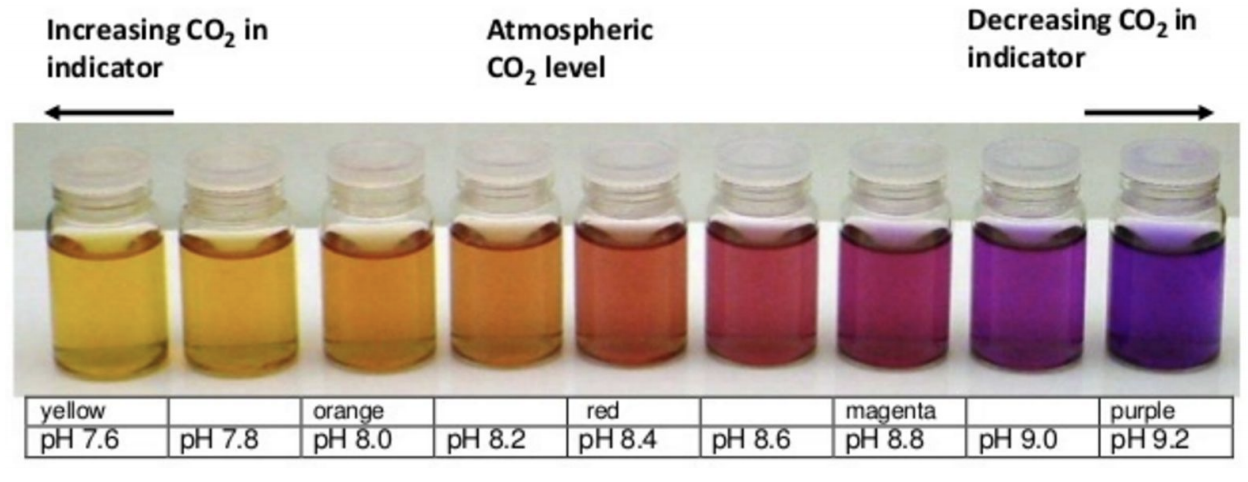
- When starting your experiment, be sure to take note of the time that you placed your vial in front of the light source. Vials should be left for ~1-2 hours.
What would happen if the algae photosynthesizes (increase O2) in a solution that started at pH8.2?
Analyzing photosynthesis results
- After 1-2 hours, return to the experiment. Without disturbing the vials, analyze and take pictures of results. Have students write down the time that their experiment ended.
- Using the color chart above, determine which pH matches your sample the closest.
- Have students determine if they got what they expected and discuss amongst their group members.
Explain how the rate of photosynthesis is affected by their different variables.
Discussion
What were your conclusions from this experiment?
If you were to repeat the experiment, what would you change and why?
What’s the relationship with O2 and CO2 during the process of photosynthesis?
Is there a “best” source of light that allowed the algae to photosynthesize better?




